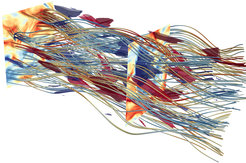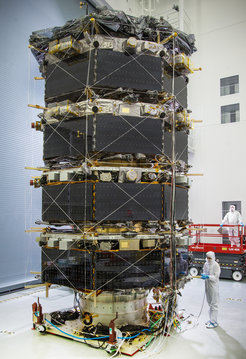How do turbulent structures form in astrophysical plasmas?
Old dispute resolved / seminal publication in Physical Review X
Do waves and structures observed in turbulent space plasmas coexist independently of each other or is there a deeper connection between the two? A team headed by IPP scientist Dr. Daniel Grošelj has now answered this old question.

The view into the night sky is deceptive: unlike seen by the human eye, the space between the celestial bodies is neither empty nor homogeneous. Instead, the vast majority of space is filled with turbulent, magnetized plasma. It contains structures of various types and sizes, waves of various kinds move through the plasma.
An important issue that has remained unresolved for decades is how this muddle should be understood. Should turbulence be regarded as “weak” – in the sense of a minor disturbance of the waves that determine the physical processes? Or is it “strong”, i.e. the turbulent structures have nothing to do with the waves and completely dominate them? The scientific literature argues vividly in favour of one or the other of these two positions.

A team headed by IPP scientist Dr. Daniel Grošelj recently published a surprising answer to this long open question in the renowned journal “Physical Review X”. Daniel Grošelj examined the measurement data recorded by the four European-American Cluster satellites and the four US American MMS satellites (Magnetospheric Multiscale Spacecraft) in the turbulent plasma of the solar wind. In particular, he compared the measurements of the magnetic field and the electron density of the solar wind plasma with the results of a complex three-dimensional simulation of the astrophysical plasma turbulence – by means of powerful numerical diagnostic methods developed by him.
The large computing power required can only be provided by today’s supercomputers. Simulations of this kind would not have been possible a few years ago.
The result: The observed turbulent structures themselves – for example electrical current sheets – show a wave-like signature. The plasma turbulence thus bears the characteristics of waves and structures. It can best be described as an entirety of spatially localized wave packets, during whose nonlinear development certain linear wave characteristics are preserved – a result that combines the two formerly completely contrary views. The authors assume that these findings will also be applicable to other turbulent wave systems, such as rotating flows.
The paper of Grošelj et al. is one of the first results of the Helmholtz Excellence Network “Munich Center for Plasma Astrophysics” headed by Professor Frank Jenko, which started work in May.
Publication:
Daniel Grošelj et al.: Kinetic Turbulence in Astrophysical Plasmas: Waves and/or Structures? In: Physical Review X, Vol. 9, 031037 (2019), DOI: 10.1103/PhysRevX.9.031037

